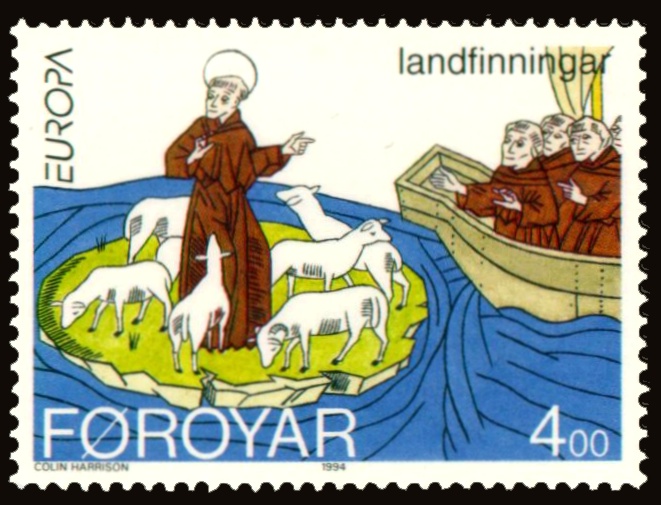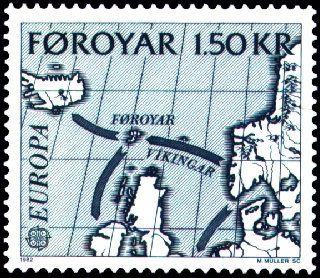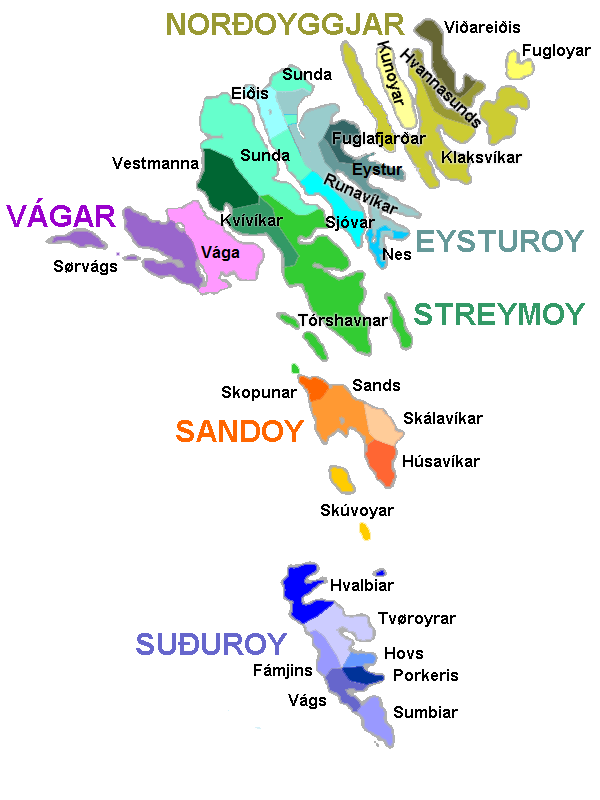A Brief History Of The Vikings In The Faroe Islands
The Norse colonisation of the Faroe Islands is documented in the ‘Færeyinga Saga‘ (literally translated as the saga of the Faroese people; also known as ‘The Saga of Thrond of Gate’), an Icelandic saga written in the early 13th century.
Unfortunately, the medieval manuscript was lost in time but several passages from it were written down in other Icelandic medieval manuscripts, specifically in ‘Óláfs saga Tryggvasonar en mesta’ (a compilation of passages from various sagas dating from the 14th century; it mainly recounts the Christianisation of King Olaf Tryggvason, King of Norway from 995 to 1000) and ‘Flateyjarbók’ (or ‘The Book of the Flat Island’ in translation; it revolves around the history of the Norse kings in a similar manner as Snorri Sturluson’s ‘Heimskringla’ does).

Faroese postage stamp depicting daily life during the Viking Age in the Faroe Islands. Image source: Wikimedia Commons
According to recent archaeological studies and also to the written accounts of an Irish monk by the name Dicuil (which date from the Dark Ages), Irish hermit monks inhabited the Faroes long before the arrival of the Norsemen, as it was the case of Iceland.

Faroese postage stamp illustrating a Viking Age longship. Image source: Wikimedia Commons
A theory has it that these hermit monks were likely part of a Hiberno-Scottish mission sent northward of Ireland and Scotland in order to explore ‘the islands in the ocean north of Britain’ (according to the writings of Dicuil). A competing theory has it that they likely fled from the British Isles because of the incursions of the Norse.
Whatever the cause of the Irish hermit monks’ arrival in both the Faroes and Iceland may be, one thing is for certain regarding the Norse settlement in the Faroese archipelago, namely the fact that the name of the first Scandinavian settler was Grímur Kamban. His name is mentioned in both the ‘Saga of Olaf Tryggvason’ and in ‘Flateyjarbók’ as the Norse discoverer of the Faroe Islands. Nonetheless, the sources are contradictory to the year of Kamban’s departure from Norway.
The Icelandic chronicle ‘Flateyjarbók’ posits that Kamban’s emigration from Norway occurred during King Harald Hårfagre’s reign (known in English as Harald Fairhair), which took place between 872 to 930 CE.
On the other hand, ‘The Saga of Olaf Tryggvason’ recounts that he settled the Faroes long before the reign of Harald Fairhair. It also indicates that the Norse were driven from Norway to the Faroe Islands because of chaotic domestic rule. However, there is a significant error in the saga, because Harald Fairhair’s reign took place in the late 9th century, while Kamban is thought to have reached the Faroes around 825.
Another interesting aspect related to the story of the first Norse settler of the Faroes is that, as paradoxical as it may seem for some, Kamban, his surname, is a Gaelic name in origin. It is usually agreed though that in about 825 Kamban settled the Faroes at Funningur (translated as ‘the find’), nowadays a village located on the western coastline of the Eysturoy island.

Faroese postage stamp illustrating Saint Brendan’s arrival in the Faroes. Image source: Wikimedia Commons
In fact, it is known that both the Faroe Islands and Iceland were inhabited by the Norse alongside their Celtic thralls from the British Isles (most notably from modern Ireland and Scotland), and to these days the genetic origins of the Icelanders and of the Faroese are of mixed Norse-Gaelic descent.
According to the writings of a Catholic order of Irish monks known as the ‘Papar’, the Irish hermit monks left the Faroe Islands because of Viking raids. It should mentioned however that the Norsemen didn’t raid the Catholic abbeys from the British Isles out of a cruel or barbarian instinct (or because of religious reasons). It was mainly wealth in which they were interested.

Faroese stamp depicting the Faroe Islands during the Viking Age. The Faroese archipelago was an important navigational hub for Norwegian Vikings between southwestern Norway, the British Isles, and Iceland, having a strategic location in the North Atlantic Ocean. Image source: Wikimedia Commons
Furthermore, the explanations behind the Norse expansion towards new lands in the west and north (as it was evidently the case of the Faroe Islands) can be identified as follows:
- overpopulation in native Scandinavia;
- internal skirmishes between the Norse earldoms and various other Norse factions in early medieval Scandinavia;
- the prospects of trade with other cultures and civilisations;
- the quest for warmer climate zones;
- the expansion of the Frankish Empire in the south of present-day Denmark;
- in the particular case of the Faroe Islands: the harsh rule of King Harald Fairhair or Finehair (Harald Hårfagre) in early medieval Norway (the first king of Norway as well) which included, but was not limited to, overtaxation.

Kunoyarnes: Typical mountainous landscape in the Faroe Islands (including salmon farms). The Faroese archipelago is dotted with many such mountainous islands. Image source: Commons Wikimedia

Map depicting the municipalities across the constituent islands of the Faroe Island. Image source: Commons Wikimedia
There are also many myths concerning the Norse culture and the Vikings in general, but most of them can trace their origin in the work of several Romanticism artists of the 19th century. One of these misconceptions (probably the most erroneous one) is that the Vikings represented a unified nation and that the term ‘Viking’ denotes a people. The term Viking does not denote a people but rather an occupation.
These are false statements, given the fact that the term ‘Viking’ referred to a young aristocrat in the Norse culture who was trying to make a name for himself or herself (yes, women could have also gone a Viking, as they say) and early medieval Scandinavia was divided in small earldoms, each ruled by a local jarl (earl) back then.
Therefore, the Vikings were an important part of the early medieval Scandinavian culture and society, but many other Norsemen were farmers, fishermen, blacksmiths, etc. Some of the Vikings were also poets, pirates and skilled traders, in addition to being warriors.
Another tremendous misconception about the Norsemen is related to the horned or winged helmets. The Norsemen didn’t wear helmets with wings or horns attached to them on the battlefield. If anything, they used this sort of headgear for ceremonial purposes (as it was the case of the Viksø helmets used in the Bronze Age on Zealand, Denmark), but it is quite unclear if they did wear them during rituals as well.
Concerning the subsequent settlement of the Faroe Islands by the Norse, an important source of information is represented by a farm located in the little village of Kvívík, situated on the island of Streymoy, the largest and most populated island of the archipelago.
A Viking Age longhouse was also excavated in the proximity of the farm, substantially providing details about the Norse lifestyle during the early Middle Ages in the Faroes. The series of excavations at Kvívík proved the validity of the Icelandic sagas, which some consider rather inaccurate or fictional. At Toftanes on Eysturoy (the second largest and most populated island of the archipelago), another longhouse dating to the Viking Age was unearthed with intact walls. It is a turf house made of stone and earth.
Documentation sources and external links:
- Vikings in the Faroe Islands on www.viking.no (in English)
- The Vikings – Iceland & the Faroe Islands on www.ivargault.com
- Did Irish monks beat the Vikings to the Faroes? Settlers were living on the remote islands 400 years before the Norse colonists on www.dailymail.co.uk
- Vikings didn’t find Faroese first (they were 500 years late) on www.theconversation.com
- First colonisers of the Faroe Islands were not the Vikings on www.dur.ac.uk (Durham University)
- History of the Faroe Islands on www.visitfaroeislands.com
- History of the Faroe Islands on www.faroeislands.com
- Faroese people on www.wikipedia.org (in English)
- Settlement and Viking Age on www.faroeislands.fo
- Flateyjarbók on www.wikipedia.org (in English)
- Timeline of Faroese history on www.wikipedia.org (in English)
- Dicuil, Irish monk on www.britannica.com
- Færeyinga Saga on www.sagadb.org (Icelandic Saga Database online)




What was that sheep doing?!!
Let’s not delve into this sort of information here. It is not what it seems like anyway. Thank you for your readership! 🙂
Assuming that the Celts from the British Islands on the Faroes was simple “thralls” is quite a claim and contradicts your criticism towards spreading rumours about vikings had horned helmets etc.
Where did you get that info from and how come the “thralls” (Celts) is the dominating male haplogroup in Iceland, Norway and all the areas the Norse” settled during “viking” while the L1 (proto Scandinavia male haplogroup) has a minimal footprint? Did the thralls they brought do all the mating? It is difficult to avoid the fact that Celts settled in Norway before and during the roman Iron age, which explain how the Celtic haplogroup is dominant along the South West coast and up to the north of Norway while L1 (proto Scandinavia) is concentrated around the inland towards Sweden away from the coast as well as any place the Norse (Celts/R1b) was raiding.
So it Celts settled Norway in pre-Roman times it is opens up the idea that many Vikings were of of Celtic origin. So many of the Faroe settlers could have been Norwegian descendants of Celts.
Uhm, well, my take on it was that it could have well been an admixture of both Norsemen of mixed Gaelic origin and Gaels from Scotland and Ireland brought by the Norwegians to the Faroes. This way it seems more balanced in my mind at least.